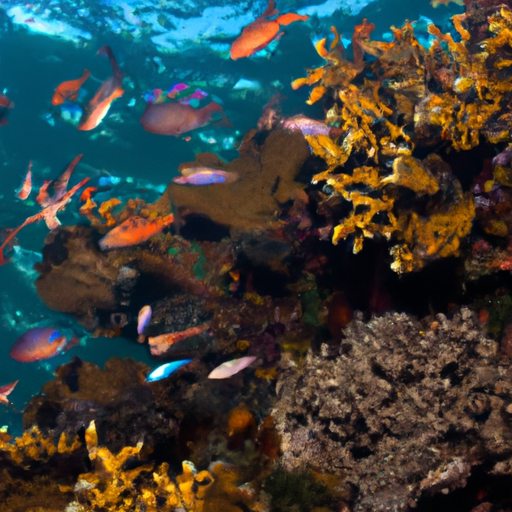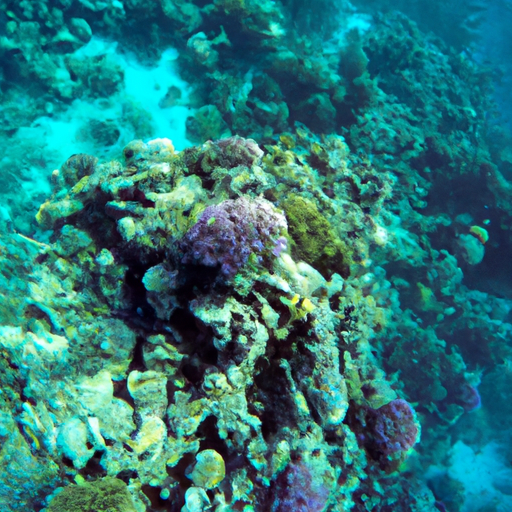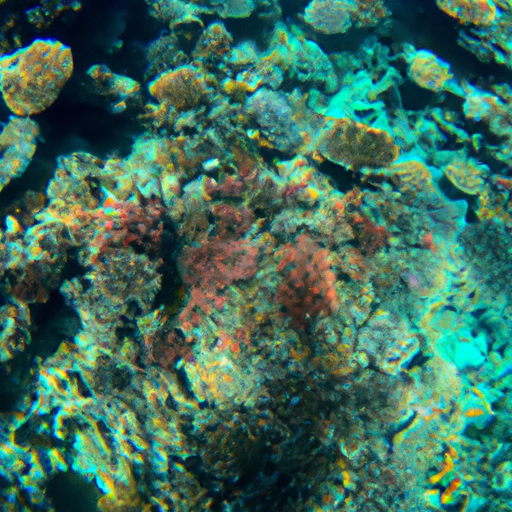
Diving into the Depths: Discovering the Wonders of Marine Biodiversity
Exploring the Fascinating World of Marine Life: A Journey into the Ocean Depths
The ocean depths are home to an incredible array of marine life, each species more fascinating than the next. Diving into these depths opens up a whole new world of discovery, giving us a glimpse into the wonders of marine biodiversity. In this article, we will delve into the mesmerizing world beneath the waves and explore the incredible diversity of marine life.
As you descend into the ocean depths, a vibrant ecosystem unfolds before your eyes. Coral reefs, teeming with life, offer a kaleidoscope of colors and shapes. These underwater cities provide a sanctuary for countless marine species, from tiny tropical fish to majestic sea turtles and elusive seahorses. The delicate balance of life within these coral ecosystems is truly remarkable and highlights the interconnectedness of all marine organisms.
However, it’s not just the coral reefs that showcase the marvels of marine biodiversity. The open ocean itself is a vast playground of life. Schools of shimmering fish dart through the water, their scales glinting in the sunlight. Powerful predators such as sharks and dolphins cruise through the depths, showcasing their strength and agility. And let’s not forget the graceful giants of the sea, the whales, whose majestic presence captivates all who have the privilege of witnessing them.
Exploring the ocean depths also introduces us to some of the most peculiar and unique creatures on the planet. Deep-sea dwelling organisms, adapted to the extreme conditions of the depths, showcase extraordinary adaptations. From the anglerfish with its bioluminescent lure to the elusive vampire squid with its jet-black skin, these creatures have evolved in ways that seem otherworldly. Their existence in the depths reminds us of the vastness of the ocean and the countless mysteries it holds.
Unfortunately, the world beneath the waves is facing numerous threats, highlighting the importance of understanding and protecting marine biodiversity. Climate change, pollution, and overfishing are just a few of the challenges that marine life must contend with. By deepening our knowledge of the incredible diversity of marine organisms, we can better appreciate the importance of preserving their habitats and ensuring their survival for future generations.
So, take a plunge into the ocean depths and discover the wonders of marine biodiversity. Let the colors, shapes, and behaviors of the diverse marine life captivate your imagination. By exploring and understanding the intricate interconnectedness of these organisms, we can work towards a future where the beauty and diversity of marine life are cherished and protected.
Unveiling the Breath-taking Colors of Coral Reefs: Exploring Underwater Paradises
Exploring the fascinating world of marine life is like embarking on a thrilling journey into the depths of the ocean. With its vastness and mystery, the ocean holds countless wonders waiting to be discovered, and one of the most mesmerizing sights to behold is the breathtaking array of colors found in coral reefs.
Coral reefs are marine ecosystems that teem with life and beauty. These underwater paradises are home to a diverse range of plants and animals, each contributing to the vibrant tapestry of colors that adorn the reef. From the vibrant yellows, oranges, and pinks of the coral polyps to the electric blue hues of the fish that dart in and out of the crevices, coral reefs are a kaleidoscope of color.
One of the primary factors responsible for the stunning colors of coral reefs is the presence of symbiotic algae called zooxanthellae. These microscopic algae live inside the tissues of the coral and provide them with energy through photosynthesis. In return, the coral provides the algae with a protected environment and essential nutrients. The partnership between the coral and zooxanthellae is crucial for the survival of both organisms and contributes to the vibrant colors seen in reefs.
However, coral reefs are not just about the corals themselves. They are also home to a plethora of marine creatures, each adding their unique hues to the underwater spectacle. From the vividly colored parrotfish to the bright orange clownfish made famous by Disney’s Finding Nemo, these inhabitants of the reef add splashes of color to the already vivid palette.
Exploring the world beneath the ocean’s surface is like stepping into a painter’s paradise. With each dive or snorkel, a whole new world of color and wonder unfolds before our eyes. The coral reefs offer a glimpse into the incredible biodiversity that exists beneath the waves, showcasing the delicate balance of nature.
As we delve into the ocean depths, we become witnesses to the intricate web of life that thrives within the coral reefs. The vibrant colors not only capture our attention but also serve as a reminder of the fragile beauty that must be protected for future generations to enjoy.
So, as we explore the fascinating world of marine life and unravel the mysteries of coral reefs, let us also become advocates for their preservation. Through responsible tourism, conservation efforts, and raising awareness about the importance of protecting these fragile ecosystems, we can ensure that the underwater paradises continue to dazzle us with their breathtaking colors for years to come.
The Untold Secrets of Oceanic Giants: A Glimpse into the Lives of Whales and Dolphins
The world beneath the ocean’s surface is a mysterious and captivating realm, filled with a wide variety of marine life that continues to astound and intrigue scientists and enthusiasts alike. Among the most fascinating creatures found in the depths of the ocean are the whales and dolphins, also known as the oceanic giants.
Whales and dolphins belong to the cetacean family, a group of marine mammals that includes over 80 species. These magnificent creatures have evolved over millions of years to thrive in various aquatic environments, from the icy waters of the Arctic to the warm tropical seas. Their adaptations and behaviors are truly remarkable.
Exploring the world of marine life reveals the astonishing diversity of species within the cetacean family. From the largest animal on Earth, the blue whale, to the acrobatic spinner dolphins, each species showcases unique characteristics and behaviors that allow them to survive and thrive in their specific habitats.
One of the most fascinating aspects of these oceanic giants is their sophisticated communication systems. Whales and dolphins are highly intelligent creatures capable of producing complex vocalizations, known as songs. These songs serve numerous purposes, including locating mates, navigating, and even identifying specific individuals within their pods.
The migratory patterns of whales and dolphins are also awe-inspiring. These creatures undertake epic journeys, traversing thousands of kilometers in search of food and breeding grounds. For example, humpback whales are known to travel from their summer feeding areas in polar regions to tropical waters for mating and calving. This long-distance migration showcases both the remarkable endurance and instinctual knowledge of these marine mammals.
The social structures of whales and dolphins are another fascinating aspect of their lives. These creatures are highly social and often travel in groups called pods. Within these pods, individuals exhibit complex relationships, with some species displaying hierarchical structures and others forming close-knit family units that endure for generations.
Beyond their social interactions, whales and dolphins play a crucial role in maintaining the balance of marine ecosystems. As apex predators, they help regulate populations of prey species and ensure the health and diversity of their habitats. Their feeding habits also contribute to the cycling of nutrients in the ocean, which is essential for the functioning of the marine food web.
When diving into the world of marine life, it becomes evident that whales and dolphins are truly extraordinary creatures. Their intelligence, communication systems, migratory patterns, social structures, and ecological significance are just a few of the many aspects that make them such captivating subjects for study and observation.
As our knowledge of these oceanic giants continues to expand, it is crucial to recognize the importance of their conservation. By understanding and appreciating the intricacies of their lives, we can work towards preserving their habitats, reducing human impacts such as pollution and noise disturbance, and ensuring a sustainable future for these remarkable creatures.
From Hidden Shipwrecks to Mysterious Underwater Caves: Exploring the Enigmatic World beneath the Waves
The ocean depths have always been a source of fascination for explorers and scientists alike. Hidden beneath the waves lies a mysterious and enigmatic world, teeming with life that remains largely unexplored. From hidden shipwrecks to mysterious underwater caves, there is an incredible variety of marine life waiting to be discovered.
One of the most captivating aspects of exploring the ocean depths is the opportunity to encounter unique and rarely seen creatures. From bioluminescent jellyfish to venomous sea snakes, the marine world is full of wonders that are both beautiful and deadly. These deep-sea creatures have evolved in extreme environments, adapting to high pressures, low temperatures, and almost complete darkness. Understanding how these organisms survive in such harsh conditions provides valuable insights into the limits of life on Earth.
Exploring the fascinating world of marine life also offers a glimpse into the interconnectedness of ecosystems. The ocean depths are home to fragile and intricate ecosystems that rely on a delicate balance of predator-prey relationships and nutrient recycling. By studying these ecosystems, scientists can better understand how changes in one part of the ocean can have far-reaching effects on the entire marine food web.
Not only does exploring the ocean depths provide valuable scientific insights, but it also offers a sense of awe and wonder. Descending into the depths, surrounded by darkness and the quiet hum of the underwater world, is a humbling experience. It reminds us of the vastness and complexity of our planet, and the need for its preservation and protection.
As technology continues to advance, so too does our ability to explore and understand the enigmatic world beneath the waves. Remote-operated vehicles (ROVs) and submersibles allow us to delve even deeper into the ocean depths, uncovering hidden treasures and unraveling the secrets of the deep. With each new expedition, we come closer to unlocking the mysteries that lie beneath the surface and gaining a deeper appreciation for the wonders of the marine world.
In conclusion, exploring the fascinating world of marine life in the ocean depths is a journey into the unknown. It allows us to witness the beauty and diversity of the underwater world, while also deepening our understanding of the complex ecosystems that exist there. It is a reminder of the importance of preserving our oceans and the need for continued exploration and research in this enigmatic realm.



